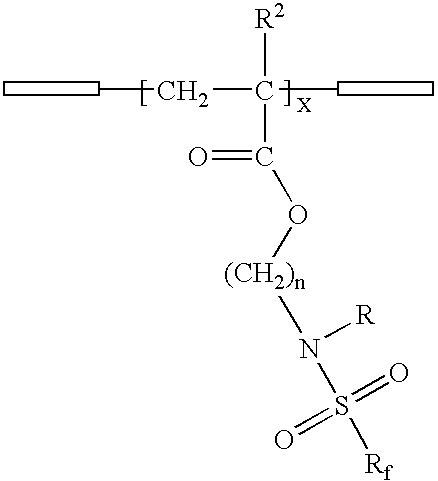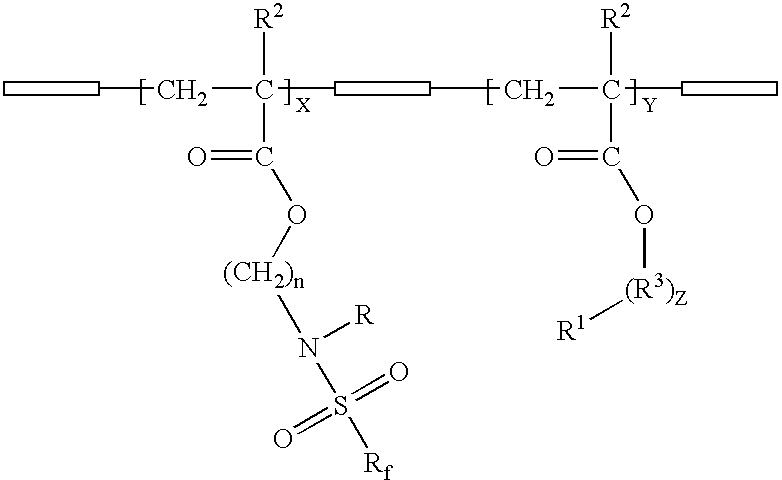Materials, methods, and kits for reducing nonspecific binding of molecules to a surface
- Summary
- Abstract
- Description
- Claims
- Application Information
AI Technical Summary
Benefits of technology
Problems solved by technology
Method used
Image
Examples
example 1
Comparison of Blocking Cocktails Containing Either a Polymeric Fluorinated or a Non-fluorinated Surfactant
[0097] An EMPHAZE AB1 reactive support loaded perfluoropoly-tetrafluoroethylene (PTFE) membrane was prepared and derivatized with Protein A. This was blocked with a bovine serum albumin solution containing either a polymeric fluorocarbon nonionic surfactant or a nonfluorinated monomeric surfactant. The membrane was then challenged with a solution of radiolabled human IgG antibody under binding conditions. The membrane was then eluted and the eluate counted to determine the recovery of the IgG.
Membrane Fabrication:
[0098] A fibrillated PTFE membrane loaded with EMPHAZE AB1 Reactive Support (3M Co., St. Paul, Minn.) was prepared according to the methods disclosed in U.S. Pat. No. 4,906,378. The final membrane was 90% by weight EMPHAZE AB1 and was about 0.8 mm thick. For use in this experiment test cartridges were prepared by securing 1.26 cm diameter disks of the membrane in th...
example 2
Blocking With a Nonionic Polymeric Fluorocarbon Surfactant to Improve Protein Recovery from a Complex Biological Fluid
[0114] I-125 labeled is spiked into a complex biological fluid and then bound to and eluted from an EMPHAZE AB1 loaded PTFE membrane that has been derivatized with Protein A.
Membrane:
[0115] A membrane fabricated as described in Experiment 1 was used except it was formed into 0.77 cm disks and secured in the bottom of the wells of a 96 well polypropylene flow through plate (as disclosed in U.S. Pat. No. 5,264,184 (Aysta et al.), U.S. Pat. No. 5,464,541 (Aysta et al.), and U.S. Pat. No. 5,620,663 (Aysta et al.)) by polypropylene retainer rings. Solutions were drawn through the membrane by centrifugal force using a plate centrifuge.
Procedure:
[0116] All reagents and buffers used were the same prepared as in Experiment 1 except that in place of the binding buffer the labeled IgG was dissolved in X-VIVO-20 Growth Medium (Cambrex Bio Science Walkersville, Inc., East ...
example 3
Comparison of Blocking Using a Nonionic Polymeric Fluorosurfactant and a Nonionic Monomeric Surfactant
[0125] The effect of treatment by either a nonionic polymeric fluorosurfactant or nonionic monomeric fluorosurfactant on the resistance to protein adsorption of a polypropylene loaded fibrillated PTFE membrane was determined by treating the membrane and then challenging with a fluorescein tagged protein.
Membrane:
[0126] A polypropylene particle loaded fibrillated PTFE membrane was fabricated as described in using polypropylene powder (No. 140S, Micropowders, Inc., Tarrytown, N.Y.). The membrane contained about 90% by weight polypropylene and was approximately 0.8 mm thick. For this experiment, it was cut into 0.77-cm diameter disks and secured by polypropylene retainer rings to the bottom of empty 2.1-cm polypropylene chromatography columns. Vacuum was used to draw solutions through the membrane.
Reagents:
[0127] Washing buffer: Phosphate Buffered Saline (No. 28372, Pierce Inc.,...
PUM
| Property | Measurement | Unit |
|---|---|---|
| Fraction | aaaaa | aaaaa |
| Fraction | aaaaa | aaaaa |
| Hydrophobicity | aaaaa | aaaaa |
Abstract
Description
Claims
Application Information
 Login to View More
Login to View More - R&D
- Intellectual Property
- Life Sciences
- Materials
- Tech Scout
- Unparalleled Data Quality
- Higher Quality Content
- 60% Fewer Hallucinations
Browse by: Latest US Patents, China's latest patents, Technical Efficacy Thesaurus, Application Domain, Technology Topic, Popular Technical Reports.
© 2025 PatSnap. All rights reserved.Legal|Privacy policy|Modern Slavery Act Transparency Statement|Sitemap|About US| Contact US: help@patsnap.com



